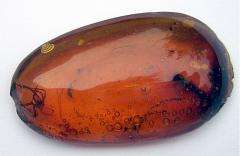A spider in amber. Image: Mila Zinkova, via Wikimedia Commons.
(PhysOrg.com) -- Pieces of amber containing parts of a spider's web have been found in East Sussex and dated back to the Cretaceous period 140 million years ago, which makes it the oldest spider's web known.
The pieces of amber (fossilized tree resin) were found last December by amateur fossil-hunting brothers Jamie and Jonathan Hiscocks on a beach near Bexhill-on-Sea in the South of England. Jamie Hiscocks told the BBC at the time that the pieces of amber were just lying on the beach for anyone to find and pick up. The beach is well-known for its fossilized dinosaur tracks.
The rare finding, believed to be the most significant amber deposit found in Britain, was analyzed by researchers at the University of Oxford. They discovered the amber contained spider web threads about a millimeter long and joined together in the roughly circular pattern of a web. The amber also contained insect droppings, plant matter, charred bark, burnt sap, and microbes. The samples also provide the earliest evidence of actinobacteria, which form soil by breaking down plant materials, a finding that will shed some light on how soil evolved.
The threads were identified as having been woven by an ancestor of today's common garden orb-weaving spider. Leader of the research team, paleobiologist Professor Martin Brasier, said orb-weaving spiders trap their prey with sticky droplets deposited on the thread, and the threads trapped in the amber had the characteristic droplets attached to them. Analysis of web and the other contents in the amber suggest the spider was feeding on the predecessors of flies, moths, bees, and wasps.
Brasier said that to his knowledge the threads were the earliest spider webs known. Coming from the base of the Cretaceous, the find is one of the oldest ambers with inclusions to be found anywhere.
The team used confocal microscopy to reconstruct the web. In this technique the amber was examined microscopically from 40 different positions, and traced through the layers. The images were then spliced together by a computer. Brasier said the techniques and technologies available today allow paleontologists to see more detail than ever before. Only a fraction of the amber pieces has been analyzed so far, and Professor Brasier believes there are more exciting discoveries ahead.
The researchers believe the web may have been trapped in conifer resin after the tree it lived on was damaged in a forest fire and produced resin to protect itself from infection. The amber was then deposited in a large lake bed that was later exposed by erosion and uplift.
The report is published in the Journal of the Geological Society.
More information: First report of amber with spider webs and microbial inclusions from the earliest Cretaceous (c. 140 Ma) of Hastings, Sussex, Martin Brasier et al., Journal of the Geological Society; December 2009; v. 166; no. 6; p. 989-997; DOI: 10.1144/0016-76492008-158
© 2009 PhysOrg.com





















